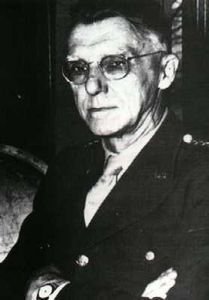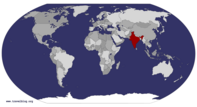Advertisement
Published: August 3rd 2008

 General Stilwell
General Stilwell
File photo of Gen StilwellStilwell Road: A Trip to Amazing US Army Achievement
Partha De Sarkar
I closed my eyes sitting in Indian Airlines’ flight IC 701 to Dibrugarh from Calcutta. We were going to Stilwell Road that is within Indian side. I shut my eyes not to sleep but to take me back to Pangsau Pass on the Indo-Myanamar (Burma) border. I could hear US Army jeeps and trucks with trailer carrying field guns rolling by and descending into Burma. Time machine had taken me back 60 years into 1942-45 period. Japanese army was playing havoc in China and Burma. Royal Air Force and US Army Air Force were crossing “ the Hump” daily with supplies of guns and ammunitions, rations, medicines and whatever could assist the Chinese under Chiang Kai-shek to fight the yellow perils. But it was crystal clear to the allied commanders that air supply was not adequate to fight a long war. So a road was absolute requirement to fight the Japanese army.
Allied commanders decided to do the impossible, to construct a road connecting Ledo in Assam, India, which was the railhead of the Assam-Bengal Railways, to Kunming, in China. In 1940s construction of a road 1079

 Architect
Architect
Gen Stilwell ably supported by Gen Merril undertook a miracle to accomplishmiles long in the naturally hostile terrain and in the face of enemy was just impossible. And this road would wind up the passes of 9000ft Patkai Range and emerge at Shindbwiyang and then Myitkyina (both in Burma) after passing through Lekhapani, Jairampur, Nampong and Pangsau Pass (all in India). It would cross the broad bowl of the Upper Chindwin, thread the Hukawng and Moganng Valleys through Burma and connect Kunming in Yunan province of China.
A pretty airhostess who had brought the food trolley broke my dream. I took a cup of coffee only and went back to 1942. The picture of ramrod straight General Joseph Warren Stilwell, Chief of Staff to Allied Forces in China-Burma-India for defence of Burma under the Generalissimo Marshal Chiang Kaishek flashed in my mind. The almost impossible task of the construction of ‘The Ledo’ road was entrusted to ‘Vinegar Joe’ as the general was known to the world, though his troops called him ‘Uncle Joe’ affectionately. But my thoughts were interrupted as we flew over the sea-like vastness of the River Bramhaputra and descended to land at Dibrugarh.
Our Tata Sumo was waiting outside the Mohonbari lounge and immediately we left

 WW II Cemetary
WW II Cemetary
Anyway, it was a destination that was different and where history, human ingenuity, blood, toil and sacrifice overwhelm you and when you return home you really tell “ Their today was for our tomorrow”. for 80km drive to Digboi. It was a very pleasant drive. We passed through miles of green paddy fields and greener tea gardens where we could see busy tea pickers working. On our way, we stopped at Chabua, where there was a WWII airfield. It was modernized and houses No. 14 Wing of the Indian Air Force. I, as a very young officer of the IAF, had spent months at Chabua. We took tea and some biscuits from roadside teashop and continued our drive for Digboi.
At Makum, we left the national highway and raced to Digboi before lunch. We checked into a hotel. We could see derricks of many oil wells from our hotel. I asked my teen-age nephew, Satyaki, if he knew why was this place called ‘Digboi’. He repled ‘No’. Then I told him the story ‘ Mr. W. L. Lake, an Englishman, was in-charge of drilling in the Borbhill. He continuously urged his work force “ Dig boy, dig.” So ultimately the place was named Digboi. It was at Digboi, the Indian oil industry was born in late 19th century.
After lunch we went to see Digboi. Like all visitors, we were at Digboi

 Tea Garden
Tea Garden
Raod to Pangsaun Pass goes through lovely tea gardensWell No.1 as it is today, a memorial for the pioneering search for oil. Presently Indian Oil Corporation runs it. Well No1 had gone on stream in October 1901 and is the second oldest functional refinery in the world.
We visited the World War II cemetery where soldiers were finally resting after fighting the Japanese in the jungle of Assam and Burma. The Commonwealth Commission maintains the cemetery. While we were reading small inscriptions on each grave, we saw the most moving inscriptions on the grave of Sgt. Roy Wilkins and it read “ When you go back home, tell them that for your tomorrow, we gave our today”. These were the men of ‘Merrill’s Marauders”.
We left Digboi early next day and reached Margherita at 6 a.m. My mind raced back to 1944. It was here at Margherita it all had started. Lieutenat Colonel (Later Major General) Frank D. Merrill Commanding Officer of “ the experienced jungle troops, for a dangerous and hazardous “Mission-somewhere” lead his specially trained 5307 Composite Unit called “Merrill’s Marauders” to the Ledo Road and started marching on foot from Margherita, near Ledo on February 7, 1944. They passed through Pangsau Pass that

 Map
Map
1944 Map of Stilwell roadwas called “Hell Pass” by the American GIs, as after crossing the pass it was only hell. They kept going on and on to Shindbwiyang, Jambu-Bam, and then to Myitkyina, most of the time fighting and struggling against rains, mud, swamps, malaria dysentery, typhoid and strategically positioned enemies at different locations on their way.
We left Margherita for Pangsua Passand reached Jairampur Gate. Now we were entering Innerline of Arunachal Pradesh.We had to produced our permit for the entry. When we reached Namphong, a brilliant idea came to Ashok’s mind. He suggested “ Hey, guys, why don’t we walk to Pangsau Pass as the “Merrill’s Marauders” did on a February wintry morning?’ We all accepted the suggestion to walk 13km. We asked our driver to start an hour later and pick us up when the going got tough in the hills.
So here we four old and middle aged Indians and a teenager doing what the tough Americans did sixty years ago. Satyaki asked me more about the Americans and I started telling him of extraordinary feats of the US Army.
“ The Americans were creating a miracle by December 1942. At Ledo they had built warehouses, hospitals,

 Pangsau Pass
Pangsau Pass
US ARMY vehicle at Pangsu Pass in 1944barracks and base road and began building the double track all weather Ledo Road. Subsequently, they brought heavy road construction machines to those wild hills like Bulldozers, Cranes, Power shovels, Caterpillars, Steamrollers, in massive procession from the United States production line 12000 miles away, across two oceans and past three continents. They had employed some of the finest mechanical road makers from America, Britain, India, China and West Africa to fight against the wild jungles, tangles of swamp and forest, deep valleys and high cliffs and test of heavy rains and floods across the Indo-Burma mountain range. But they carried on regardless.”
We were now climbing the Pangsua Pass and we knew it would be tough. We were no GI Joes. But I continued my story of extraordinary bravery “ On December 27, 1943, 3 days ahead of the schedule the road reached Shindbwiyang and was before schedule of January 1, 1944 as General “Vinegar Joe” Stilwell wished. A convoy came rolling into Shindbwiyang with candy, doughnuts and 9600 cans of beer. As I had told earlier, though the troops had marched off Margherita on February 27, 1944, the construction went on side by side. In late 1944 “

 Road from Pangsau Pass
Road from Pangsau Pass
As the road looks today from angsau PassThe Ledo Road” connected the Burma Road stretching from Assam in India to Kunming in China, 1079 miles long. On January 12, 1945 the first convoy of 113 vehicles was led by General Pick from Ledo and reached Kunming on February 4, 1945 and celebrated the achievement”.
We had walked 6 of 13 km and we all preferred to be picked up by our Tata Sumo that had followed, after all the Americans, too, had used trucks and jeeps. After an hour we were standing on Pangsua Pass or “ Hell Pass” as the “Merrill’s Marauders” called it while they descended from it into Burma. I looked down and saw nothing much of “ Stilwell Road” left beyond the Indian side. But we could still see some tracks far below us, covered by jungles. I asked little Satyaki to be silent and listen to the noise of the Americans marching down, jeeps and trucks rolling down with field guns. It was all there but only in our imagination.
But the story of the miracle continued as Satyaki had become a fan of the Americans and started calling Stilwell “Uncle Joe” as his troops did. So here went my story “ Four inch pipelines were laid side by side and followed along the Ledo Road from Tinsukia in Assam, India to relieve the road and air traffic from India to China. They were fed by gasoline pumped from Calcutta to a station near their starting point.
In the meantime, on war front Merrill’s marauders seized Myitkyina airstrip on May 17, 1944, captured Myitkyina town despite strong resistance from the Japanese forces. Two months long campaign ended on August 3, 1944. Merrill’s Marauders had suffered 127 deaths and 291 wounded besides other casualties. Myitkyina was one of the main missions of General Stilwell. On May 20, 1945 Major General Lewis A. Pick of US Army Engineers formally declared the completion of the Ledo Road, a task he called “ the toughest job ever given to US Army Engineers in Wartime”. The Stilwell Road from Ledo to Kunming spanned 10 major rivers and 155 secondary streams. The road was renamed “The Stlwell Road” in the honour of General Joseph Warren Stilwell at the suggestion of Chiang Kai-shek.” Thus ended my story.
It was a romantic feeling standing on the Pangsua Pass but it was sad that Stilwell Road has virtually disappeared in the course of time. Even of the 37 miles in Indian side 9 miles of Assam was in deplorable state while 28 miles of Arunachal Pradesh was well maintained. It definitely a memorial of the American troops and engineers and we paid our respect to their memory while expecting the world, more so America, should regard what ever is left of Stilwell Roda as a heritage site.
Anyway, it was a destination that was different and where history, human ingenuity, blood, toil and sacrifice overwhelm you and when you return home you really tell “ Their today was for our tomorrow”.
While returning, at Namphon we could see the dance of the Adi tribes of Arunachal Pradesh. The dancers were dressed in very bright ethnic dress. The girls were beautiful as was their dancing. It was a bonus over above fantastic experience of the Stilwell Road.
For visiting Stilwell Road www.globalhoptravels.com
Advertisement
Tot: 0.072s; Tpl: 0.012s; cc: 9; qc: 52; dbt: 0.0425s; 1; m:domysql w:travelblog (10.17.0.13); sld: 1;
; mem: 1.2mb









